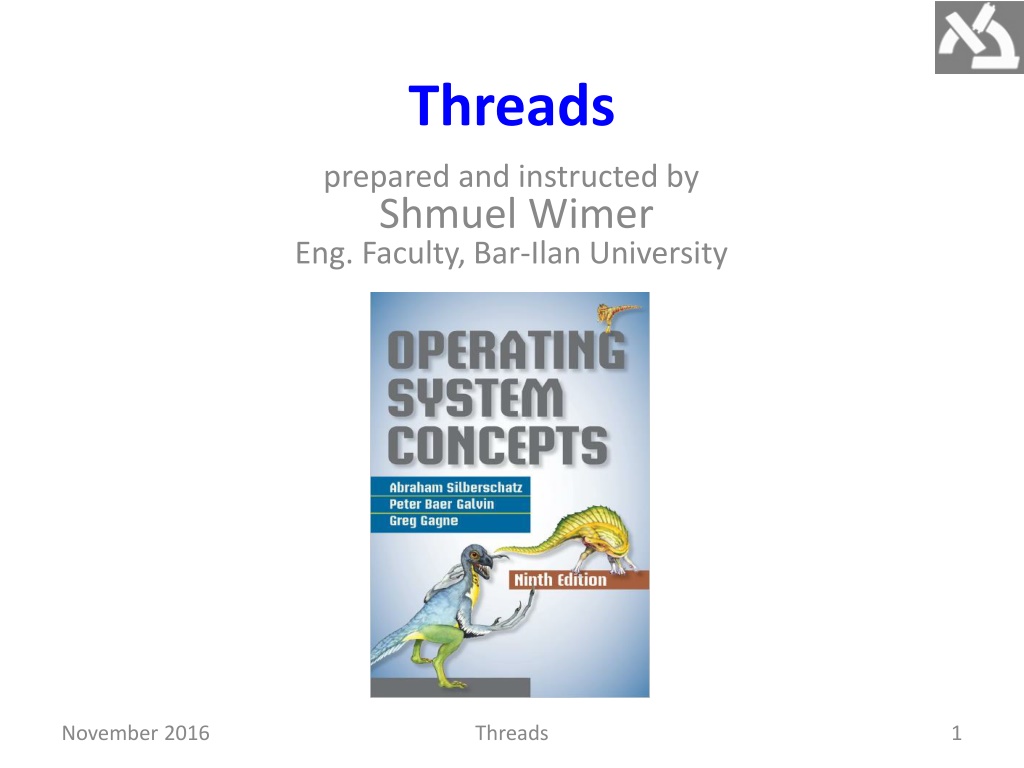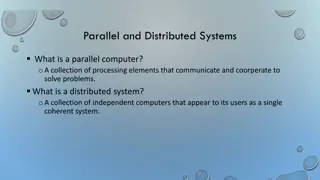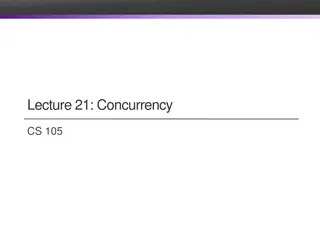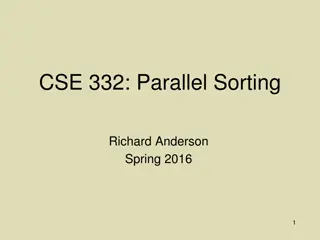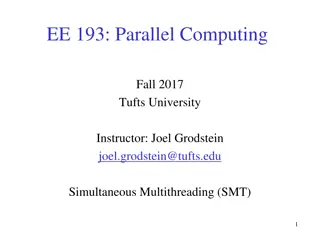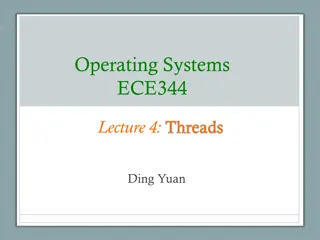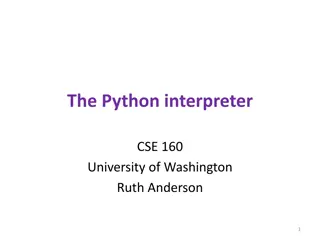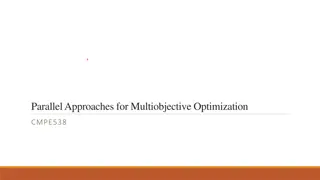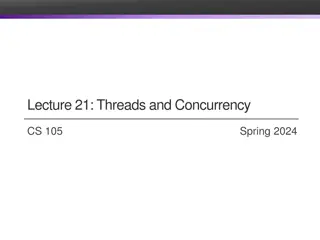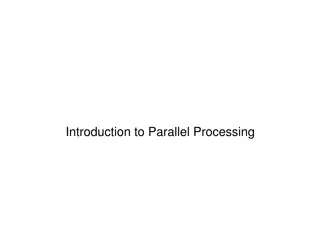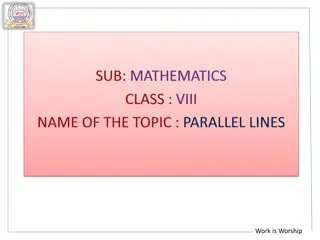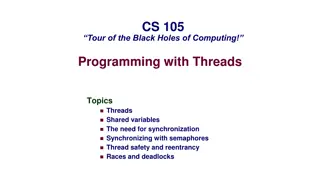Threads - Running Parallel Processes & Enhancing Performance
Threads are essential for achieving parallelism in processes, boosting performance, and improving responsiveness in modern computer applications. Learn about the benefits and applications of multithreaded programming.
Download Presentation

Please find below an Image/Link to download the presentation.
The content on the website is provided AS IS for your information and personal use only. It may not be sold, licensed, or shared on other websites without obtaining consent from the author.If you encounter any issues during the download, it is possible that the publisher has removed the file from their server.
You are allowed to download the files provided on this website for personal or commercial use, subject to the condition that they are used lawfully. All files are the property of their respective owners.
The content on the website is provided AS IS for your information and personal use only. It may not be sold, licensed, or shared on other websites without obtaining consent from the author.
E N D
Presentation Transcript
Threads prepared and instructed by Shmuel Wimer Eng. Faculty, Bar-Ilan University November 2016 Threads 1
Thread Usage Threads are kind of processes within a process, sharing address space, running as they were separate processes. Useful on systems with multiple CPUs, where real parallelism exists, also in single CPU with multiple ALUs. In many applications multiple activities are going on at once. Some may block from time to time. Decomposing it into multiple sequential threads running quasi-parallel simplifies programming model. Threads creation and destruction is X10-X100 faster than processes (context switch). November 2016 Threads 2
Thread Hardware A thread switch should be much more efficient than a process switch, which typically requires hundreds to thousands of processor cycles. November 2016 Threads 3
Overview Having multiple threads running in parallel in one process is analogous to having multiple processes running in parallel in one computer. November 2016 Threads 4
Single-threaded and multithreaded processes. November 2016 Threads 5
Most applications running on modern computers are multithreaded. An application is implemented as a separate process with several threads. Example: Web browser has a thread displaying images or text. Another thread retrieves data from network. Example: Word processor has graphics display thread, another responding keystrokes, and thread performing background spelling and grammar checking. CPU-intensive applications perform tasks in parallel to leverage processing capabilities on multicore systems. November 2016 Threads 6
Example: A web server accepts concurrently thousands client requests for web pages, images, sound, etc. Single-threaded process is able to service only one client at a time. Client will wait long time for service. Upon request the server creates a separate, time and resource consuming process. A huge overhead. Multithreaded server architecture. November 2016 Threads 7
Most todaysOS kernels are multithreaded. Each thread performs a specific task, such as managing devices, managing memory, or interrupt handling. The benefits of multithreaded programming are: Responsiveness to user. For instance, when user clicks button triggering execution of time-consuming task. Resource sharing. Processes share resources by shared memory and message passing, handled by programmer. Threads share automatically memory and resources of the process to which they belong. November 2016 Threads 8
Economy. Allocating memory and resources for process creation is costly. X30 slower process creation than thread, X5 slower context switching (Solaris). Scalability. Benefits are greater in multiprocessor, where threads run in parallel on different cores. Single-threaded process can run on only one processor, regardless how many are available. November 2016 Threads 9
Like process, a thread can be in running, blocked, ready, or terminated states. state transitions are same as for process. Running thread currently has the CPU and is active. Blocked thread is waiting for some event to unblock it, e.g. read from the keyboard. Ready thread is scheduled to run and will when its turn comes up. Each thread has its own stack, containing one frame for each procedure called but not yet returned. It contains the procedure s local variables and the return address. November 2016 Threads 10
Multicore Programming Multiple CPUs, named multicore or multiprocessor (MP) systems, are integrated on single chip. time Parallel execution on a multicore system. November 2016 Threads 11
A core appears as a separate processor to the OS. Multithreaded programming provides more efficiency and improved concurrency. A system is parallel if it performs more than one task simultaneously. In contrast, a concurrent system supports more than one task by allowing all the tasks to make progress. Modern Intel CPUs support 2 threads per core (4-16), Oracle T5 CPU supports 16 threads per core (16). November 2016 Threads 12
MP Programming Challenges Identifying tasks. Divide application into separate, concurrent tasks, running in parallel on individual cores. Balance. Define tasks performing equal work of equal value. Data splitting. The data accessed and manipulated by the tasks should be divided to run on separate cores. Data dependency. When task depends on data of another, ensure that tasks execution is in sync. Testing and debugging. It is more difficult for concurrent programs than single-threaded applications. November 2016 Threads 13
Types of Parallelism Data parallelism.Distributes subsets of same data across multiple cores, each performing the same operation. Example: Summing an N-size array. On single-core, one thread sums the elements [0] . . . [N 1]. On dual-core the data can be split into two halves for two threads running in parallel on separate cores. Task parallelism.Distributes tasks (threads) across multiple cores, Each performing a unique operation. Different threads may operate on the same or different data. Applications may use a hybrid of parallelism types. November 2016 Threads 14
Multithreading Models User threads are managed without kernel support. Kernel threads are supported and managed directly by the OS. Relationship exists between user and kernel threads. Many-to-one model. November 2016 Threads 15
The many-to-one model maps many user-level threads to one kernel thread. Thread management is done by the library in user space, so it is efficient. The entire process will block if a thread makes a blocking system call. Because only one thread can access the kernel at a time, multiple threads are unable to run in parallel on multicore systems. One-to-one model maps each user thread to a kernel thread. November 2016 Threads 16
One-to-one model. One-to-one provides more concurrency than many-to- one by allowing another thread to run when thread makes blocking system call. It also allows multiple threads to run in parallel on multiprocessors. Linux and MS-Windows OS implement one-to-one. November 2016 Threads 17
A drawback is that creating a user thread requires creating the corresponding kernel thread. Because overhead of creating kernel threads burden performance, one-to-one implementations restrict the number of threads in the system. Many-to-one allows creation of many user threads, but not true concurrency, because of the single thread. One-to-one allows greater concurrency, but care must be taken not to create too many threads. November 2016 Threads 18
Thread Libraries A thread library provides the programmer with an API for creating and managing threads. There are two ways of implementing a thread library. User space with no kernel support. All code and data structures for the library exist in user space. Invoking a function in the library results in a local function call in user space and not a system call. The second approach implements a kernel-level library supported directly by the OS. November 2016 Threads 19
Library code and data structures exist in kernel space. Invoking a function in the API for the library results in a system call to the kernel. Example: A multithreaded program that performs ??? = ?=0 ?. The upper bounds of the summation is entered on the command line. ? There are two strategies to create multiple threads: asynchronous and synchronous. With asynchronous, once the parent thread creates a child thread, the parent resumes its execution, so parent and child execute concurrently. November 2016 Threads 20
Each thread runs independently of other threads. The parent need not know when its child terminates. Because of independency, there is little data sharing between threads. Synchronous threading occurs when the parent must wait for all of its children to terminate before it resumes, called fork-joinstrategy. November 2016 Threads 21
Thread header Parent thread fork join November 2016 Threads 22
November 2016 Threads 23
POSIX Pthread code for joining ten threads. November 2016 Threads 24
